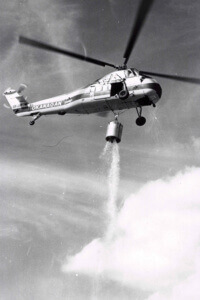While helicopters are a familiar — and reassuring — sight above wildfires today, the use of this new technology in tackling blazes in the wild was considered highly experimental when it began in the Angeles National Forest in 1945. Organized through a joint effort between the U.S. Forest Service and the U.S. Army Air Force (USAAF), the tests used Sikorsky R-4, R-5A, R-5D, and R-6 aircraft to explore the suitability of helicopters for fire control in mountainous country; while the Army and Navy had experience operating the aircraft at sea level, the helicopter’s performance at higher altitudes was a relatively unknown quantity.
In Canada, the helicopter made its official firefighting debut on June 16, 1946, when a prototype Bell 47 was used for reconnaissance of an active wildfire near Sudbury, Ontario, for the Ontario Department of Lands and Forests (ODLF). A month later, a USAAF Sikorsky R-5A was used on a forest fire in Alaska, completing short shuttle runs from Fairbanks to the blaze near Tanana River, carrying firefighters and their equipment.
The first recorded use of a helicopter on an active fire in the contiguous United States was on Sept. 9, 1946, when a single USAAF Sikorsky R-5A was used to map and scout a forest fire near Castaic, California, and also dropped supplies along its perimeter. The following summer — Aug. 5 1947, to be precise — two Bell 47B helicopters from Armstrong-Flint Helicopter Company were used to fight the Bryant Fire in the Angeles National Forest in California. Flown by Knute Flint and Fred Bowen, the two aircraft flew four missions within two hours of their arrival. The aircraft proved their worth in a wide variety of missions on the fire, and made such a difference to the operation that the Bryant Fire is widely seen as a watershed moment in the evolution of the use of the helicopter in fighting wildfires, marking its transition from an untested curiosity to a proven firefighting tool.

An Okanagan Helicopters Sikorsky S-58 demonstrates a water drop using a tank slung underneath the fuselage.
The operator originally used an internal tank that carried 270 US gallons (1,022 liters) of water or retardant.
Okanagan Helicopters/Bob Petite Collection Photo
[excerpted]http://www.verticalmag.com/features/buckets-belly-tanks/#sthash.2ZjWb90t.dpuf